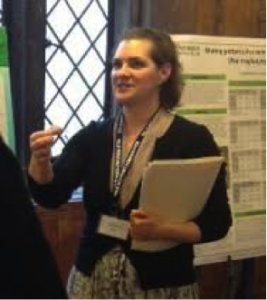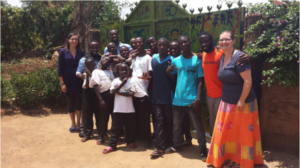 ABOUT JANELLE: Janelle Junkin is a PhD candidate in the Creative Arts in Therapy program at Drexel University. Janelle conducts research on the impact of the MindLeaps’ program on the participating students; she has completed research at Drexel in addition to being in the field in Rwanda. Janelle is involved in several areas of research with MindLeaps; first, she completed a program evaluation in December 2015. Second, she is analyzing data with a partner organization to determine if there is a viable predictability model for MindLeaps’ students success stories at boarding school. In January 2016, Janelle trained four MindLeaps boys using a data collection tool to determine selectivity bias. Finally, since January 2015, Janelle has worked with on ground staff in Rwanda analyzing the skills measured by MindLeaps to determine student progress in both cognitive and non-cognitive skills. We sat down with Janelle to ask her about her experience and thoughts on MindLeaps and her work.
ABOUT JANELLE: Janelle Junkin is a PhD candidate in the Creative Arts in Therapy program at Drexel University. Janelle conducts research on the impact of the MindLeaps’ program on the participating students; she has completed research at Drexel in addition to being in the field in Rwanda. Janelle is involved in several areas of research with MindLeaps; first, she completed a program evaluation in December 2015. Second, she is analyzing data with a partner organization to determine if there is a viable predictability model for MindLeaps’ students success stories at boarding school. In January 2016, Janelle trained four MindLeaps boys using a data collection tool to determine selectivity bias. Finally, since January 2015, Janelle has worked with on ground staff in Rwanda analyzing the skills measured by MindLeaps to determine student progress in both cognitive and non-cognitive skills. We sat down with Janelle to ask her about her experience and thoughts on MindLeaps and her work.
How did you get involved with MindLeaps?
JJ: In the fall of 2013, I was doing a literature search for my dissertation, and I came across an article on the Rebecca Davis Dance Company (RDDC). The article discussed work that it had been doing abroad, and mentioned that RDDC was based in Philadelphia and that the Executive Director, Rebecca Davis, lived there. I had never heard about programs like this in Philly, so I emailed Rebecca. We later set up a Skype chat, and I interviewed her to get background info for the dissertation.
How did MindLeaps fit into your PhD studies as a Creative Arts Therapist?
JJ: Initially I wasn’t sure because I already had my dissertation site lined up, but when I transferred to Drexel, there was a requirement for a 9 month Research Practicum. I had previously been working with MindLeaps on an informal basis, and my advisor suggested that I turn this into a study by formalizing MindLeaps as the focus and learning of my Research Practicum. The Practicum proposal I submitted included: Measuring skill progress in the students in dance classes, providing background on Rwanda and its street/out-of-school children, traveling to Rwanda to do a program evaluation and setting the groundwork for near-future research studies. This included collecting data about street children who are part of MindLeaps and street children who are not part of MindLeaps, and using data from the boarding school to see if there is any way to predict how MindLeaps students perform once they enroll in school.
What interested you about this research?
JJ: There were a couple of different areas of interest for me. First, it was a company that was using dance as a way to develop and support cognitive and non-cognitive skills. My first thought was “Yes!” I completely see that this works, and I was excited to work on how we show that and prove that to other people, so that they, too, shared in the excitement of the work.
What was your background in the arts?
JJ: I’m a Board-certified music therapist, and a classically trained flautist, and have competed and performed in orchestras, and I play piano, guitar, and percussion. As a music therapist, I also completely understand the value and importance of the arts in supporting change in people. That’s never been a question in my mind.
When I began my journey as a PhD student I knew I would be doing a lot of sitting, so I joined a dance studio. It was a great outlet to move my body and understand how my body moves in space. As I was learning dance, I could relate it to what I was learning in school, so my own personal experience helped me understand how this could work in a broader sense.
What was your experience visiting MindLeaps?
JJ: I initially visited the site in Rwanda in August 2015 where I collected data for the program evaluation and the predictability model. During that time I was most struck by the fact that the kids would come- they would come before their class and then they would go to their class, and then they would stay after. And it wasn’t mandatory and some of these kids had to walk and walk to get there. There was something they were getting from the classes, but also from each other, and from the staff as well. I was also really struck by the family atmosphere- seeing and hearing the staff really care about these children, and ensuring that they get the best possible life that they can, and using dance to help them achieve that. Psychologically, I suspect that is a big contributor to the success of the kids, complementary to the dance.
In January 2016, you returned to Rwanda to work on the selectivity bias data collection, can you share a story about an experience you had with the youth during that time?
JJ: In January 2016, I was working with four MindLeaps boys who would go out and do data collection on street children who are not part of MindLeaps. So these are four boys in their late teen years, with a 3rd or 4th grade education, and speak little English. I had the opportunity to train them to go out to complete research surveys, without having any clear sense of whether this would work…will we get the information we need? Did the kids even want to do this research?
On the first day, the kids packed their bags, and went out…and they came back and their work was really good. After the week, the kids had collected 200 forms. I spoke with them after and they were very interested in understanding what would be done with the information; they all said they wanted to help me more, and they said, “If you write a book, we want to write it with you.” To see the ownership that they took on the project, and that these kids with a 3rd or 4th grade education said, “I want to write a book!” drove home for me that we should never underestimate what people can do. Ever. And these kids have value to contribute if we give them the space and tools to do it.
Were there any unexpected challenges in collecting or analyzing the data?
JJ: There are always unexpected challenges in collecting and analyzing the data! For me, it was being an American who doesn’t speak Kinyarwanda, and who doesn’t have a full grasp of Rwandan culture and street children. We knew from a data perspective and research question what information we needed to find, but didn’t know how to collect it. For instance, we really needed to know the socio-economic status of the parents. In the U.S., we would ask: do you make under $15,000, $15,000-$25,000, etc., but that is not an option in a Rwandan context. So it became: do your caretakers work? If they work, what do they do? We had to get creative about how to find the right information.
As you are completing analysis of the various data, have you found any findings significant?
JJ: Significant results emerged during the initial data analysis of the skills that I completed in the spring of 2015. At first, MindLeaps was recording the progress on 11 different skills. A research team from Carnegie Mellon and myself looked at the data and we saw some skills being measured did not change over time. So we revised the skills, turned it into a 7 point Likert system, and then re-ran the analysis. The findings confirmed:
- Several skills within three months of the program had statistically significant changes. So we can say with authority that if someone participates in MindLeaps, they will improve in 3 months in these skills.
- Over the 3 month to 6 month period, some kids continued to improve, but not all, so it is not quite as significant.
- Over the 6-9 months period, the kids sustained their new level, but there was no improvement that is statistically significant. At that point, they plateau, so at 6 months, it would probably be ideal to add in a new class, or measure something different.
As a qualitative researcher, of the narratives we gathered, there was an area of significance that stood out: Hope. One kid said “there was no hope for my life until I came to MindLeaps, and now I have hope for my future. I can hope to be a dancer; I can hope to give back too and make a better life for people like me.”
Here is this organization, MindLeaps, which employs Rwandans to do the work. These kids get to see people who look like them, who have similar life experiences, who are now investing in them, and that gives them the understanding that they have the ability to invest in others. So I think there is a huge significance in that potential for generational change. Eleven staff who are impacting 90 students, who could exponentially impact 180 or more. At this point, you can’t measure the long-term impact, but you can begin to hear it in the narratives.
What new questions came up from this process, and what do you think MindLeaps and other organizations need to explore going forward?
JJ: On a practical level, we need to ask: what measurement tools are appropriate when we talk about street children? Are we getting the information we need to know? And specific to MindLeaps, we need to tease apart the skill building across the months: What is contributing to their ability to make that improvement? Internal resilience that we haven’t measured? Is it the dance, or dance in combination with other classes? Is it the relationship they are building with each other and the staff? I expect all things are contributing, but we don’t know how much of each is making this impact on them. This is an important question to explore at some point.
Also we should do a cross comparison study of what is happening in MindLeaps’ programs in Rwanda vs. Guinea vs. Bosnia-Herzegovina. What is different about each program and why is it successful in each location? This will be important in order to expand in the future and to make sure that other organizations have the factors in place to successfully implement the model.
Long term, there should be a study that looks at dance and cognition. Can we explain neurobiological and neuropsychological pieces that are contributing to how dance is relating to cognitive development in these children? There also needs to be further research conducted on the biology of dance in people recovering from trauma.
Read About Janelle’s work with MindLeaps in Drexel University’s Publication.
